
7-19 Harris Street
The slope down to Elizabeth Macarthur Bay was busy even before CSR arrived: a timber yard and a tin smelter used the land from at least the 1850s. When CSR built the sugar refinery in the 1870s, this land was vital: with access to the Bay and to the new Harris Street, it performed mundane…

21 Harris Street
The block at 21 Harris Street, on the corner of Bowman Street was briefly a site of strategic importance. During the Second World War, Australia also needed war material. As CSR engineers and chemists responded to this crisis, houses were removed from the site and engineering workshops built, to produce gun barrels, shell casings, Verey…

Antias
Antias has a complex and baffling past. Before the site was quarried, it was much higher than it is today. Residents in the new building (named after a Pyrmont street which has disappeared) look onto Blackwattle Bay. There, barges would load stone from the quarries, before there was a track for horse-drawn drays. CSR expanded into…

Cadigal Terraces
The Terraces, designed by Richard Huxley and finished in 2000, are named in a gesture towards the Aboriginal inhabitants of this part of Sydney. It was believed that the Cadigal (or Gadigal) clan of the Eora people occupied much of Sydney south of the harbour, and numbered between 50 and 80 people when the First…

Cooperage
This four-story commercial office block is adaptively reused and the work was completed in 2006. The exterior was redesigned by heritage architect Howard Tanner, and the interior design by Form Follows Function. In 1901 CSR closed its distillery in Fiji and replaced it with a much larger facility in Pyrmont. Rum was one of the…

Distillery Hill
Ultimo and its deer park occupied most of the peninsula into the 1840s, so Aboriginal people may have lived here after Pyrmont (the north-eastern corner) was turned over to industry. Quarrying began in the 1850s however: residents in The Quarry overlook the closest of the three major Saunders quarries – Paradise – and the Quarry…

Elizabeth
Designed by Jackson Dyke, and completed in 2000, the building is named for Elizabeth, wife and better half of ambitious and litigious John Macarthur, soldier and early holder of the Pyrmont land grant. During John’s many periods of trial, exile and overseas trips, Elizabeth managed his business, maritime and pastoral interests. “It was to the…
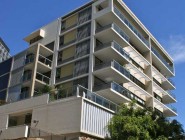
Escarpment
Designed by Tony Caro and completed in 2004, Escarpment occupies the site of the former CSR Central Laboratory. Sugar farmers (in Queensland, northern New South Wales and Fiji) were paid only after their cane was crushed and refined. Their payment reflected the sucrose content of their cane, not the residual fibre (megass or bagass), so…
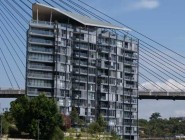
Evolve
The western tip of Pyrmont quickly attracted entrepreneurs: barges could moor close to quarries. As the city was near but out of sight, it hosted necessary but noisy processes. Shipyards on the eastern side of the peninsula attracted Fyfes Iron Foundry in 1855, and City Iron Works in 1865. A bridge linked Glebe Island to…
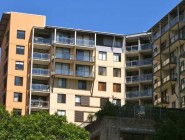
Fleetview
Fleetview is the ten-storey building designed by Cox Richardson and completed in 2001, across Refinery Square from The Station. It is bounded by Bowman St, Mount St Walk and Refinery Drive. Several CSR functions occupied this site, and some of these changed throughout CSR’s tenure of what is now Jacksons Landing. The most durable structure…

John Street
John Street has been mainly residential since the mid-nineteenth century. West of Harris Street, CSR bought houses whenever they could, for their employees. Apart from the three pubs and the public school, almost all the cottages were rented to refinery or distillery workers. When Lend Lease acquired the CSR estate, therefore, they could replace most…

Knox on Bowman
Designed by Tzannes & Associates and completed in 2006, this building commemorates Edward Knox (1820-1901) and his son Edward William Knox (1863-1932), general managers of CSR which they helped create and build into an industrial giant. In 1843 Edward became manager of the Australasian Sugar Company, which evolved into CSR in 1855. His business skills…
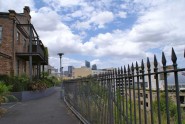
McCafferys Hill
McCafferys Hill, the highest point of the Pyrmont peninsula, comprises six buildings: McCafferys Tower, Johns Court, Cliff Top, The Stables, Chalet and the Mews. McCafferys buildings were designed by Daryl Jackson Robin Hyde, and opened in 2003 (except for The Stables, designed by Jon Johannsen and completed in 2004). The buildings overlook sandstone quarries (Paradise,…

Mount Street Walk Terraces
Designed by Zulaikha Greer and completed in 2000, these terrace houses front a street created after CSR departed and Lend Lease moved in. In CSR’s heyday two streets – McCredie and New – ran between Bowman and Harvey. Mount Street Walk runs between these streets, closer to New than McCredie. Houses on New Street dated…
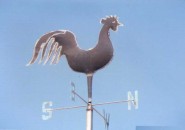
Refinery Square
Refinery Square was the nerve centre of CSR operations from 1906 when the Administration Office was built here. Horse-drawn drays (later trucks) entered and left the complex here, and cargo was weighed. The Administration building housed offices and the carpenters’ workshop. Here workers lined up to receive their wages at the paymaster’s window. A large…

Reflections
Sydney entrepreneurs were attracted to Pyrmont as it was easily reached by boat, but far enough from the city for noisy or dirty activity. John MacArthur encouraged development, and boat building began here in 1838 and 1840, some years before the peninsula was incorporated into Sydney. Quarrying followed. Saunders’s yellow block sandstone quarries were more…

Regatta Wharf
Before CSR built its refinery, Chowne’s shipyard occupied Johnston’s Bay at what is now Regatta Wharf. The refinery took two years to build: when it was established, 90 staff refined 400 tons of sugar each week. The enterprise expanded to about 4,000 tons over a century, and diversified into other products, but the refinery was…

Rum Store
Daryl Jackson Robyn Dyke restored this building in 2000, as a five-storey apartment block of 13 units. Timber floors, hardwood beams, cast iron windows and sandstone window sills preserve the form of the original building. The building dates from 1879 as an important part of the CSR operation. It seems never to have stored rum:…

Silk
Surgeon Harris’s Ultimo Estate included the site of the present Silk, but it had little commercial value except for small-scale quarrying, until CSR began buying land in the 1870s. Soon afterwards, a Char House was built south of the Silk site, to burn animal bones for use in the refinery. CSR had no other use…
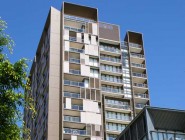
Stonecutters
Designed by Tzannes and Associates, and completed in 2009, the building evokes the quarrying which transformed the Jacksons Landing area before CSR moved here in the 1870s. Sydney (actually Hawkesbury) sandstones formed millions of years ago, when this was the delta of an immense river. Pyrmont’s ‘self-colouring’ yellowblock variant is light grey until exposed to…

Sugar Dock
Surgeon Harris’s Ultimo Estate included the site of the present Sugar Dock, but it had little commercial value, apart from small-scale quarrying, until CSR began buying land in the 1870s. CSR had little use for this land until 1901, when a distillery was built to produce rum, and then industrial spirits. As the distillery expanded,…

Tablet House
The building was erected in 1909, to make tablet sugar, syrup and other products. Renovated as a three-storey office block, the building retains many original features, such as the load-bearing window frames, the open plan layout made possible by cast iron beams, the loading dock opening to Refinery Square and the lift well (now glazed)…